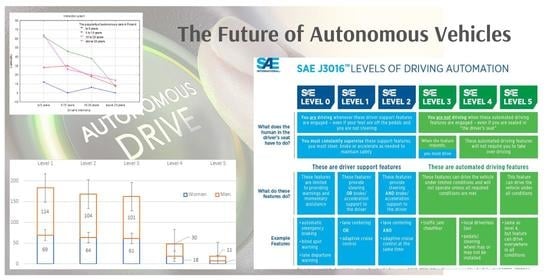The Future of Autonomous Vehicles in the Opinion of Automotive Market Users
Abstract
1. Introduction
- Level 0: the driver performs all tasks related to driving and there is no automation.
- Level 1 (Driver’s assistant): It is implemented by systems that automate a specific element of driving, and the driver is obliged to keep their hands on the steering wheel and watch the traffic on the road. So, the driver controls most driving functions, but under certain conditions the vehicle may be able to adjust the cruise control speed or stay on the road lane.
- Level 2 (partial automation): Corresponds to semi-autonomous driving—in the case of traffic jams on the road, the vehicle can autonomously take over driving, steering and braking. The car can both accelerate/decelerate and perform basic steering functions. The driver is still responsible for steering the navigation (e.g., exit from the highway, change of lane or turn onto a new street).
- Level 3 (conditional automation): on-board systems are already able to take over all driving functions, but only in certain cases; however, the driver must be alert at all times and ready to take over—their car can therefore monitor the driving environment and accelerate, turn or brake, but still awaits human intervention upon notification.
- Level 4 (high automation): fully autonomous driving, vehicles communicate with each other and inform each other about, e.g., change of lane, and the driver does not have to constantly observe the surrounding traffic on the road; the car can control all aspects of driving and operate without human intervention, but only under certain conditions.
- Level 5 (full automation): the car is fully autonomous in all driving conditions and does not require human intervention—the technology system can perform all driving tasks in all circumstances, and the passengers are only passive passengers and never have to participate in driving and perform any driving tasks.
2. Materials and Methods
- Knowledge of autonomous vehicle technology;
- Attitude to this technology;
- Barriers and challenges resulting from the introduction of this technology.
3. Results and Discussion
3.1. Autonomy Levels in the Automotive Market
3.2. Barriers and Challenges in the Field of Autonomous Vehicles
3.3. The Future of Autonomous Vehicles in Poland Based on Research Results
- Respondents positively evaluated the concept of AVs up to level 3 (SVs+), while levels 4 and 5 were rated quite poorly. Moreover, in each age group, there was a greater awareness of the introduction of vehicle autonomy levels among men than among women, who did not show level 5, and level 4 was shown only sporadically.
- Only about 30% of respondents knew AV technology and almost 60% “heard some-thing about this technology”. This shows how low the awareness is about innovative solutions in the road transport sector among the respondents.
- The average time of AV introduction in Poland was estimated at 10–20 years and over 20 years.
- Due to the place of residence, the most popular vehicles in the future were indicated by the following: HVs, EVs, AVs and SVs, followed by SVs+.
- Due to the age of the respondents, the most popular vehicles in the future were indicated as HVs, EVs and SVs, followed by AVs and SVs+.
- Due to the length of driving license, the most popular vehicles in the future were indicated by the following, successively: HVs, EVs, SVs and AVs, with SVs+ last.
- In the group of active drivers, the respondents indicated the popularity of HVs, EVs and SVs, and then AVs. On the other hand, HVs, EVs and SVs were indicated as the most popular among inactive drivers.
- Among the main barriers for the introduction of AVs in Poland, the respondents indicated the following: price, safety, disputed liability, social mentality and hacker attacks.
4. Conclusions
Author Contributions
Funding
Institutional Review Board Statement
Informed Consent Statement
Data Availability Statement
Conflicts of Interest
References
- Nikitas, A.; Kougias, I.; Alyavina, E.; Tchouamou, E.N. How can autonomous and connected vehicles, electromobility, brt, hyperloop, shared use mobility and mobility-as-a-service shape transport futures for the context of smart cities? Urban Sci. 2017, 1, 36. [Google Scholar] [CrossRef]
- Gavanas, N. Autonomous Road Vehicles: Challenges for Urban Planning in European Cities. Urban Sci. 2019, 3, 61. [Google Scholar] [CrossRef]
- Riedmaier, S.; Schneider, D.; Watzenig, D.; Diermeyer, F.; Schick, B. Model validation and scenario selection for virtual-based homologation of automated vehicles. Appl. Sci. 2021, 11, 35. [Google Scholar] [CrossRef]
- Chan, C.Y. Advancements, prospects, and impacts of automated driving systems. Int. J. Transp. Sci. Technol. 2017, 6, 208–216. [Google Scholar] [CrossRef]
- SAE International. SAE J3016_201806, Taxonomy and Definitions for Terms Related to Driving Automation Systems for On-Road Motor Vehicles; SAE International: Washington, DC, USA, 2016. [Google Scholar]
- Panagiotopoulos, I.; Dimitrakopoulos, G. An empirical investigation on consumers’ intentions towards autonomous driving. Transp. Res. Part C 2018, 95, 773–784. [Google Scholar] [CrossRef]
- SAE Standards News: J3016 Automated-Driving Graphic Update. Available online: https://www.sae.org/news/2019/01/sae-updates-j3016-automated-driving-graphic (accessed on 19 July 2021).
- Casey, J.P. The Future of Autonomous Vehicles. Available online: https://www.roadtraffic-technology.com/comment/future-autonomous-vehicles/ (accessed on 19 May 2021).
- Asselin-Miller, N.; Biedka, M.; Gibson, G.; Kirsch, F.; Hill, N.; White, B.; Uddin, K. Study on the Deployment of C-ITS in Europe: Final Report; European Commission: Brussels, Belgium, 2016. [Google Scholar]
- 5GAA. C-ITS Vehicle to Infrastructure Service: How C-V2X Technology Completely Changes the Cost Equation for Road Operators; White Paper; 5G Automotive Association: Munich, Germany, 2018. [Google Scholar]
- Analysis Mason Limited, 5GAA. Socio-Economics Benefits of Cellular V2X; 5G Automotive Association: Munich, Germany, 2017. [Google Scholar]
- Martínez, A.; Cañibano, E.; Romo, J. Analysis of Low Cost Communication Technologies for V2I Applications. Appl. Sci. 2020, 10, 1249. [Google Scholar] [CrossRef]
- Miao, L.; Virtusio, J.J.; Hua, K.-L. PC5-Based Cellular-V2X Evolution and Deployment. Sensors 2021, 21, 843. [Google Scholar] [CrossRef]
- Bartuska, L.; Labudzki, R. Research of basic issues of autonomous mobility. LOGI 2019-Horizons of Autonomous Mobility in Europe. Transp. Res. Procedia 2020, 44, 356–360. [Google Scholar] [CrossRef]
- Charness, N.; Yoon, J.S.; Souders, D.; Stothart, C.; Yehnert, C. Predictors of attitudes toward autonomous vehicles: The roles of age, gender, prior knowledge, and personality. Front. Psychol. 2018, 9, 2589. [Google Scholar] [CrossRef]
- Das, S.; Sekar, A.; Chen, R.; Kim, H.C.; Wallington, T.J.; William, E. Impacts of autonomous vehicles on consumers time-use patterns. Challenges 2017, 8, 32. [Google Scholar] [CrossRef]
- Nieoczym, A.; Tarkowski, S. The modeling of the assembly line with a technological Automated Guided Vehicle (AGV). Logforum 2011, 7, 35–42. [Google Scholar]
- Papa, E.; Ferreire, A. Sustainable accessibility and the implementation of automated vehicles: Identifying critical decisions. Urban Sci. 2018, 2, 5. [Google Scholar] [CrossRef]
- Pettigrew, S.; Fritschi, L.; Norman, R. The potential implications of autonomous vehicles in and around the workplace. Int. J. Environ. Res. Public Health 2018, 15, 1876. [Google Scholar] [CrossRef] [PubMed]
- Stopka, O. Modeling the Delivery Routes Carried out by Automated Guided Vehicles when Using the Specific Mathematical Optimization Method. Open Eng. 2020, 10, 166–174. [Google Scholar] [CrossRef]
- Siqueira Silva, D.; Csiszár, C.; Földes, D. Autonomous vehicles and urban space management. Sci. J. Sil. Univ. Technol. Ser. Transp. 2021, 110, 169–181. [Google Scholar] [CrossRef]
- Tian, Z.; Feng, T.; Tommermans, H.J.P.; Yao, B. Using autonomous vehicles or shared cars? Results of a stated choice experiment. Transp. Res. Part C Emerg. Technol. 2021, 128, 103117. [Google Scholar] [CrossRef]
- Fagnant, D.J.; Kockelman, K.M. Dynamic ride-sharing and fleet sizing for a system of shared autonomous vehicles in Austin, Texas. Transportation 2018, 45, 143–158. [Google Scholar] [CrossRef]
- Haboucha, C.J.; Ishaq, R.; Shiftan, Y. User preferences regarding autonomous vehicles. Transp. Res. Part C Emerg. Technol. 2017, 78, 37–49. [Google Scholar] [CrossRef]
- Self-Driving Cars will Profoundly Change the Way People Live. The Economist. 1 March 2018. Available online: https://www.economist.com (accessed on 4 August 2021).
- Jamroz, K.; Kustra, W.; Budzynski, M.; Zukowska, J. Pedestrian protection, speed enforcement and road network structure the key action for implementing Poland’s Vision Zero. Transp. Res. Procedia 2016, 14, 3905–3914. [Google Scholar] [CrossRef]
- Kristianssen, A.C.; Andersson, R.; Belin, M.A.; Nilsen, P. Swedish Vision Zero policies for safety–A comparative policy content analysis. Saf. Sci. 2018, 103, 260–269. [Google Scholar] [CrossRef]
- Rosencrantz, H.; Edvardsson, K.; Hansson, S.O. Vision Zero–Is it irrational? Transp. Res. Part A Policy Pract. 2007, 41, 559–567. [Google Scholar] [CrossRef]
- Zwetsloot, G.I.J.M.; Kines, P.; Ruotsala, R.; Drupsteen, L.; Merivirta, M.L.; Bezemer, R.A. The importance of commitment, communication, culture and learning for the implementation of the Zero Accident Vision in 27 companies in Europe. Saf. Sci. 2017, 96, 22–32. [Google Scholar] [CrossRef]
- Xu, Z.; Zhang, K.; Min, H.; Wang, Z.; Zhao, X.; Liu, P. What drives people to accept automated vehicles? Findings from a field experiment. Transp. Res. Part C 2018, 95, 320–334. [Google Scholar] [CrossRef]
- Payre, W.; Cestac, J.; Delhomme, P. Intention to use a fully automated car: Attitudes and a priori acceptability. Transp. Res. Part F 2014, 27, 252–263. [Google Scholar] [CrossRef]
- Gkartzonikas, C.; Gkritza, K. What have we learned? A review of stated preference and choice studies on autonomous vehicles. Transp. Res. Part C Emerg. Technol. 2019, 98, 323–337. [Google Scholar] [CrossRef]
- Poliak, M.; Mrnikova, M.; Simurkova, P.; Medvid, P.; Poliakova, A.; Hernandez, S. Social law in road transport like tool safety road transport. In Proceedings of the 2018 XI International Science-Technical Conference Automotive Safety, Casta, Slovakia, 18–20 April 2018; IEEE: Piscataway, NJ, USA. [Google Scholar] [CrossRef]
- Törő, O.; Bécsi, T.; Aradi, S. Design of lane keeping algorithm of autonomous vehicle. Period. Polytech. Transp. Eng. 2016, 44, 60–68. [Google Scholar] [CrossRef]
- Moravcik, L. Typové schválenie autonómnych (samojazdiacich) vozidiel, Type approval of autonomous (self-driving) vehicles. Perner’s Contacts 2020, 15, 2. [Google Scholar] [CrossRef]
- Nagy, S.; Csiszár, C. The quality of smart mobility: A systematic review. Sci. J. Sil. Univ. Technol. Ser. Transp. 2020, 109, 117–127. [Google Scholar]
- Škultéty, F.; Beňová, D.; Gnap, J. City logistics as an imperative smart city mechanism: Scrutiny of clustered EU27 capitals. Sustainability 2021, 13, 3641. [Google Scholar] [CrossRef]
- Del Vecchio, P.; Secundo, G.; Maruccia, Y.; Passiante, G. A system dynamic approach for the smart mobility of people. Implications in the age of big data. Technol. Forecast. Soc. Chang. 2019, 149, 119771. [Google Scholar] [CrossRef]
- Jittrapirom, P.; Caiati, V.; Feneri, A.M.; Ebrahimigharehbaghi, S.; Gonzalez, M.J.A.; Narayan, J. Mobility as a service: A critical review of definitions, assessments of schemes and key challenges. Urban Plan. 2017, 2, 13–25. [Google Scholar] [CrossRef]
- Sandor, Z.P.; Csiszar, C. Role of integrated parking information system in traffic management. Period. Polytech. Civil Eng. 2015, 59, 327–336. [Google Scholar] [CrossRef]
- Automotive Industry Report 2018/2019. Available online: https://www.pzpm.org.pl/Publikacje/Raporty/Raport-branzy-motoryzacyjnej-2018-2019 (accessed on 4 August 2021).
- Shin, J.; Bhat, C.R.; You, D.; Garikapati, V.M.; Pendyala, R.M. Consumer preferences and willingness to pay for advanced vehicle technology options and fuel types. Transp. Res. Part C 2015, 60, 511–524. [Google Scholar] [CrossRef]
- Daziano, R.A.; Sarrias, M.; Leard, B. Are consumers willing to pay to let cars drive for them? Analyzing response to autonomous vehicles. Transp. Res. Part C 2017, 78, 150–164. [Google Scholar] [CrossRef]
- Begg, D. A 2050 Vision for London: What are the Implications of Driverless Transport; Transport Times: London, UK, 2014. [Google Scholar]
- Kyriakidis, M.; Happee, R.; De Winter, J.C.F. Public opinion on automated driving: Results of an international questionnaire among 5000 respondents. Transp. Res. Part F 2015, 32, 127–140. [Google Scholar] [CrossRef]
- Csiszár, C.; Földes, D. System model for autonomous road freight transportation. Promet Traffic Transp. 2018, 30, 93–103. [Google Scholar] [CrossRef]
- Zarkeshev, A.; Csiszár, C. Are people ready to entrust their safety to an autonomous ambulance as an alternative and more sustainable transportation mode? Sustainability 2019, 11, 5595. [Google Scholar] [CrossRef]
- Winter, S.R.; Keebler, J.R.; Rice, S.; Mehta, R.; Baugh, B.S. Patient perceptions on the use of driverless ambulances: An affective perspective. Transp. Res. Part F Traffic Psychol. Behav. 2018, 58, 431–444. [Google Scholar] [CrossRef]
- Balm, S.; Browne, M.; Leonardi, J.; Quak, H. Developing and evaluation framework for innovative urban and interurban freight transport solutions. Procedia Soc. Behav. Sci. 2014, 125, 386–397. [Google Scholar] [CrossRef][Green Version]
- Schliwa, G.; Armitage, R.; Aziz, S.; Evans, J.; Rhoades, J. Sustainable city logistics–making cargo cycles viable for urban freight transport. Transp. Bus. Manag. 2015, 15, 50–57. [Google Scholar] [CrossRef]
- Tettamanti, T.; Varga, I.; Szalay, Z. Impacts of autonomous cars from a traffic engineering perspective. Period. Polytech. Transp. Eng. 2016, 44, 244–250. [Google Scholar] [CrossRef]
- Shariff, A.; Bonnefon, J.-F.; Rahwan, I. Psychological roadblocks to the adoption of self-driving vehicles. Nat. Hum. Behav. 2017, 1, 694–696. [Google Scholar] [CrossRef] [PubMed]
- Noy, I.Y.; Shinar, D.; Horrey, W.J. Automated driving: Safety blind spots. Saf. Sci. 2018, 102, 68–78. [Google Scholar] [CrossRef]
- Silberg, G.; Manassa, M.; Everhart, K.; Subramanian, D.; Corley, M.; Fraser, H.; Sinha, V. Self-driving Cars: Are we ready? Tech. Rep. KPMG 2013, 1–36. Available online: https://assets.kpmg/content/dam/kpmg/pdf/2013/10/self-driving-cars-are-we-ready.pdf (accessed on 4 August 2021).
- Schoettle, B.; Sivak, M. A Survey of Public Opinion about Autonomous and Self-driving Vehicles in the U.S., the U.K., and Australia; Transportation Research Institute, University of Michigan: Ann Arbor, MI, USA, 2014. [Google Scholar]
- Underwood, S.E. Automated vehicles forecast vehicle symposium opinion survey. In Proceedings of the Automated Vehicles Symposium, San Francisco, CA, USA, 15–17 July 2014. [Google Scholar]
- König, M.; Neumayr, L. Users’ resistance towards radical innovations: The case of the self-driving car. Transp. Res. Part F Traffic Psychol. Behav. 2017, 44 (Suppl. C), 42–52. [Google Scholar] [CrossRef]
- Brown, B.; Drew, M.; Erenguc, C.; Hasegawa, M.; Hill, R.; Schmith, R.; Ganula, B. Global Automotive Consumer Study: The Changing Nature of Mobility–Exploring Consumer Preferences in Key Markets Around The World. Technical Report, Deloitte. 2014. Available online: https://www2.deloitte.com/content/dam/Deloitte/global/Documents/Manufacturing/gx-mfg-geny-automotive-consumer.pdf (accessed on 19 May 2021).
- Casley, S.V.; Jardim, A.S.; Quartulli, A.M. A Study of Public Acceptance of Autonomous Cars, Interactive Qualifying Project, Worcester Polytechnic Institute. 2013. Available online: https://web.wpi.edu/Pubs/E-project/Available/E-project-043013-155601/unrestricted/A_Study_of_Public_Acceptance_of_Autonomous_Cars.pdf (accessed on 21 May 2021).
- Shabanpour, R.; Golshani, N.; Shamshiripour, A.; Mohammadian, A.K. Eliciting preferences for adoption of fully automated vehicles using best-worst analysis. Transp. Res. Part C Emerg. Technol. 2018, 93, 463–478. [Google Scholar] [CrossRef]
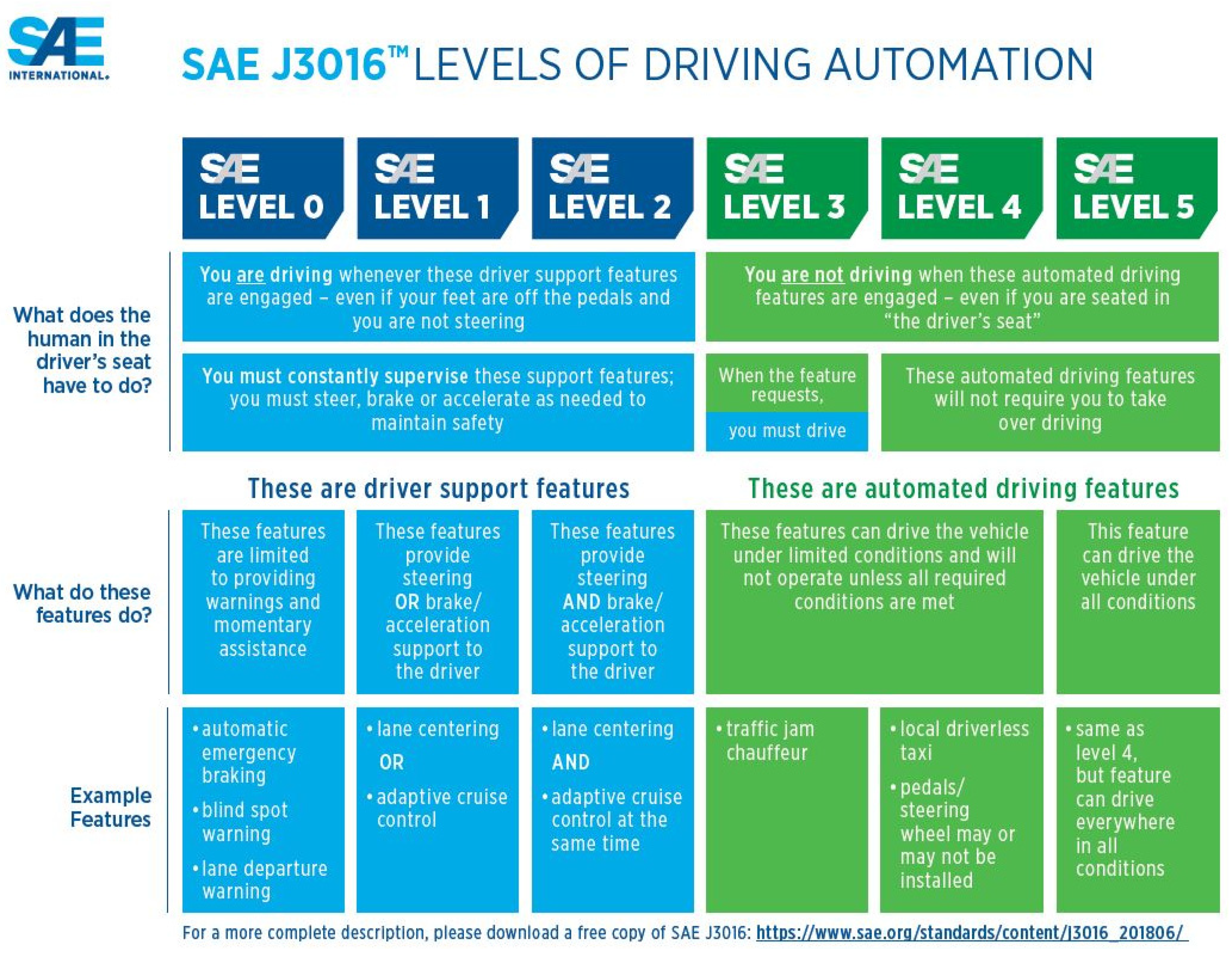
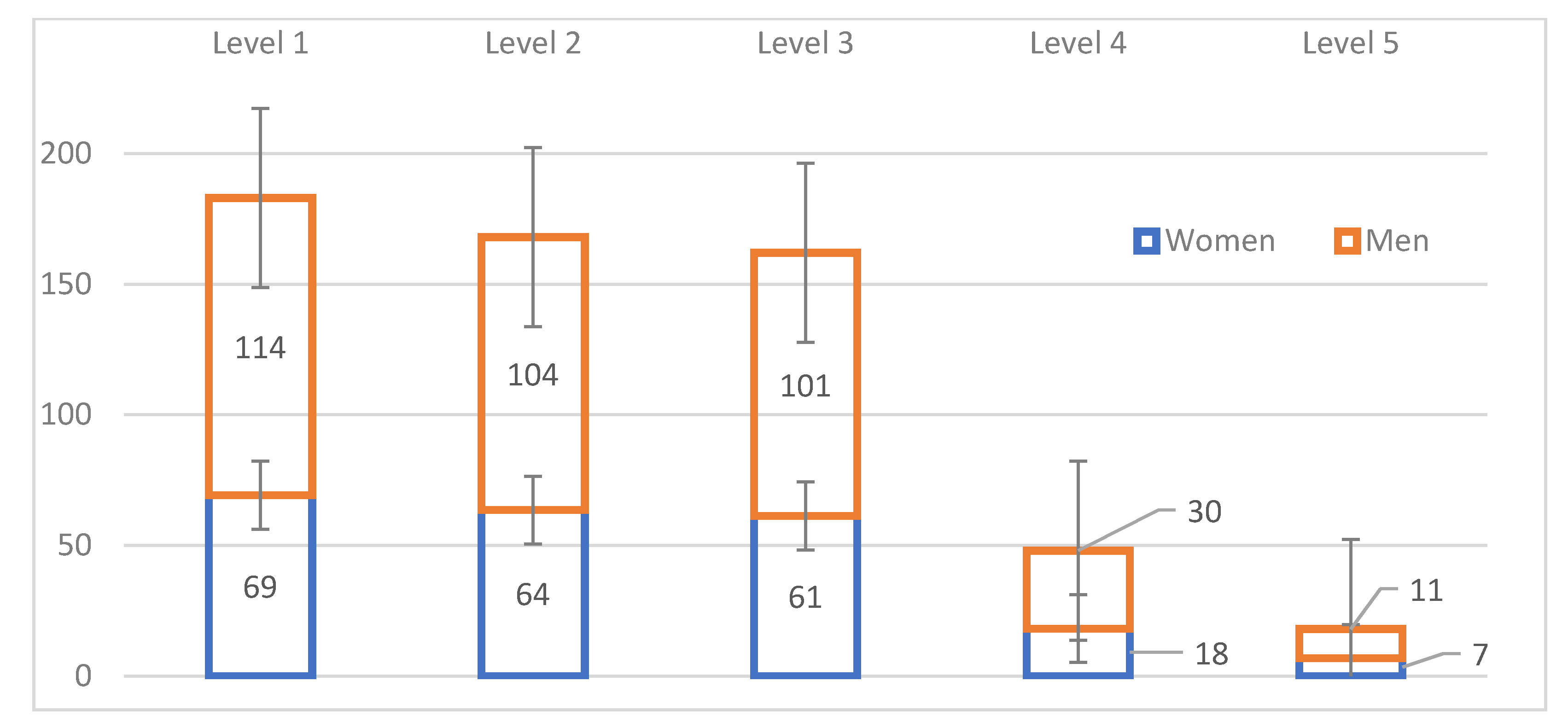
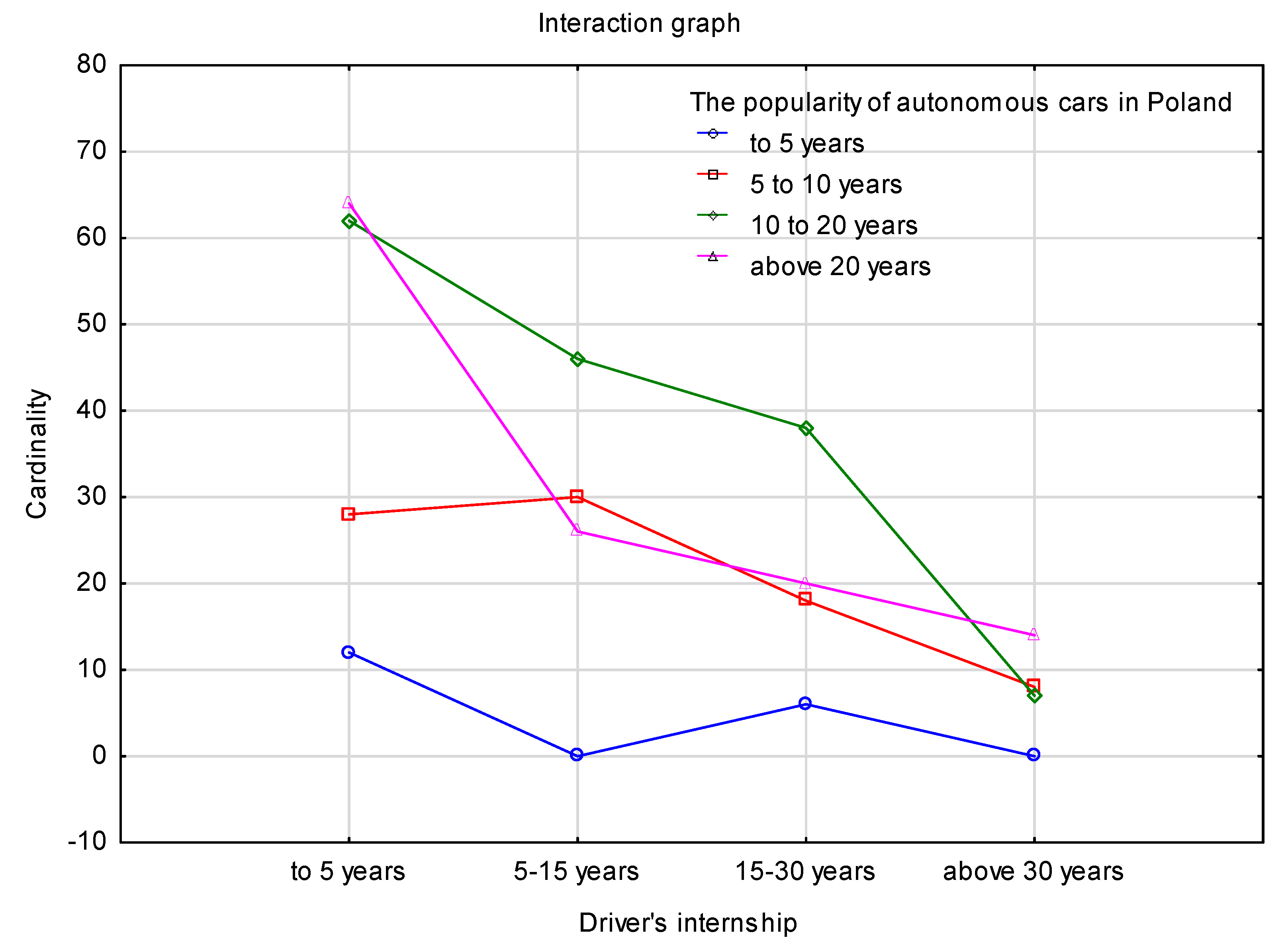
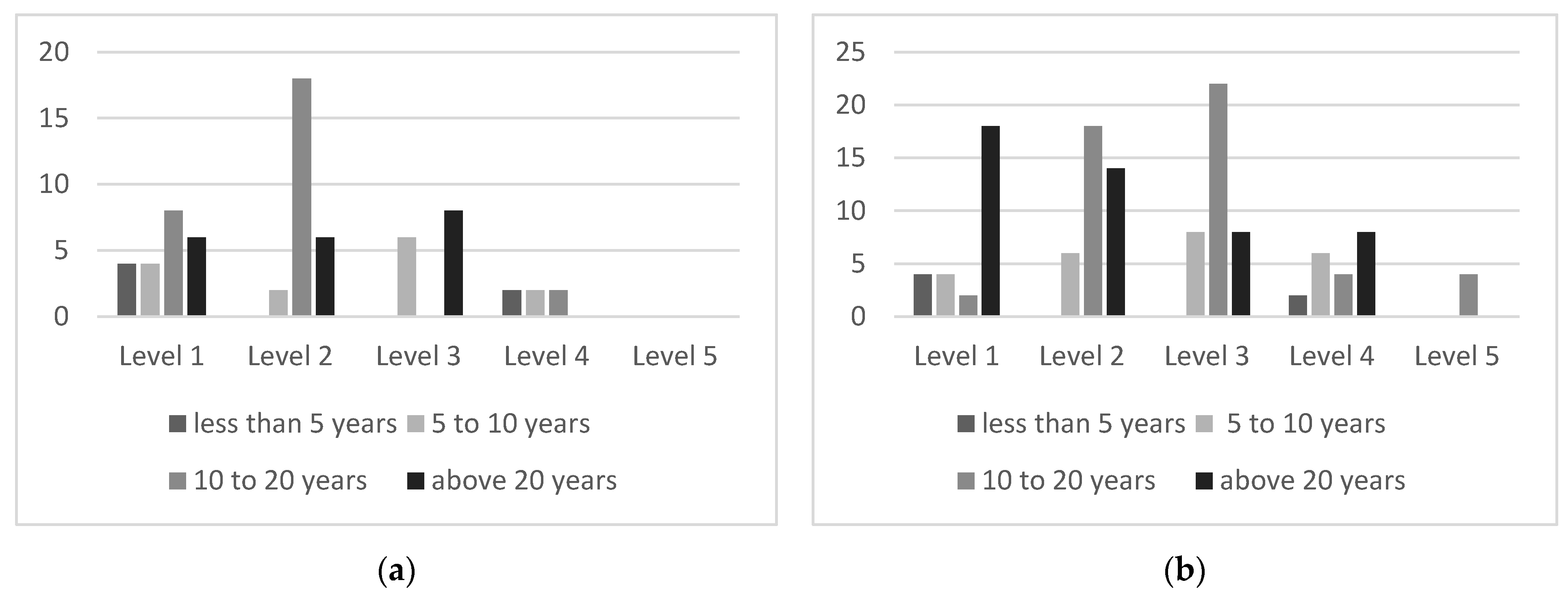
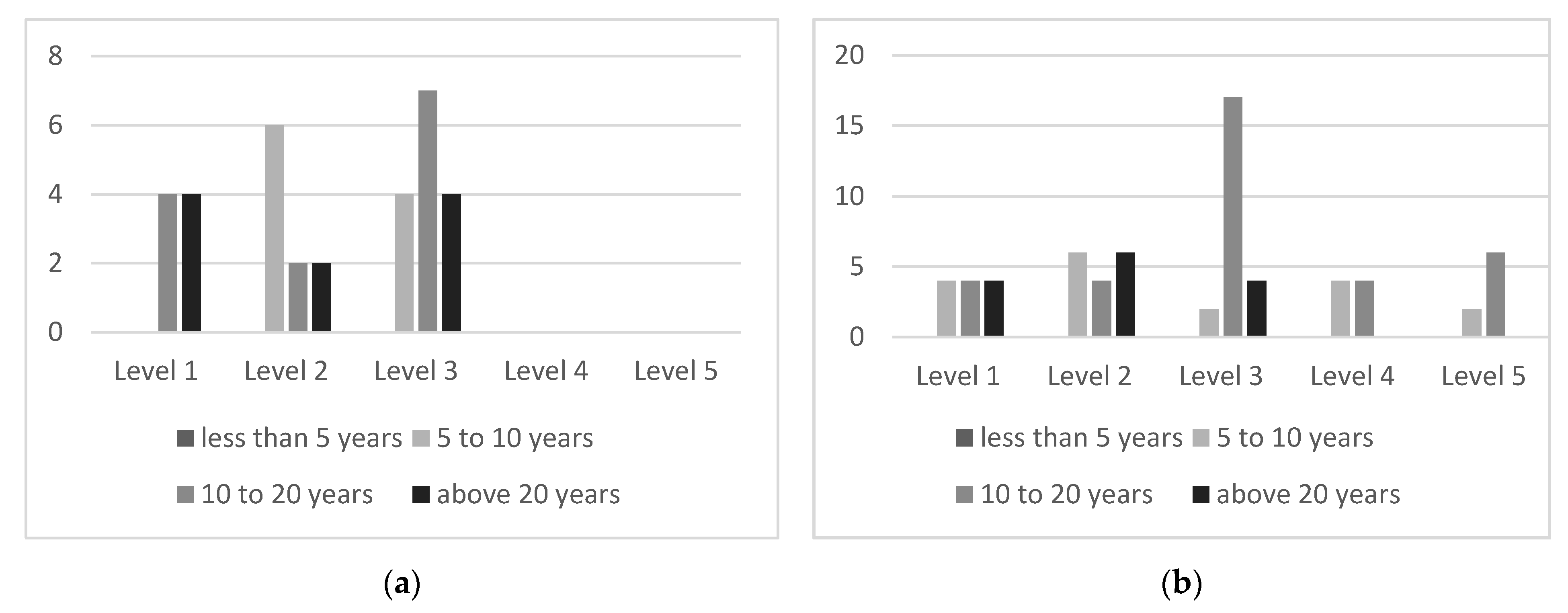
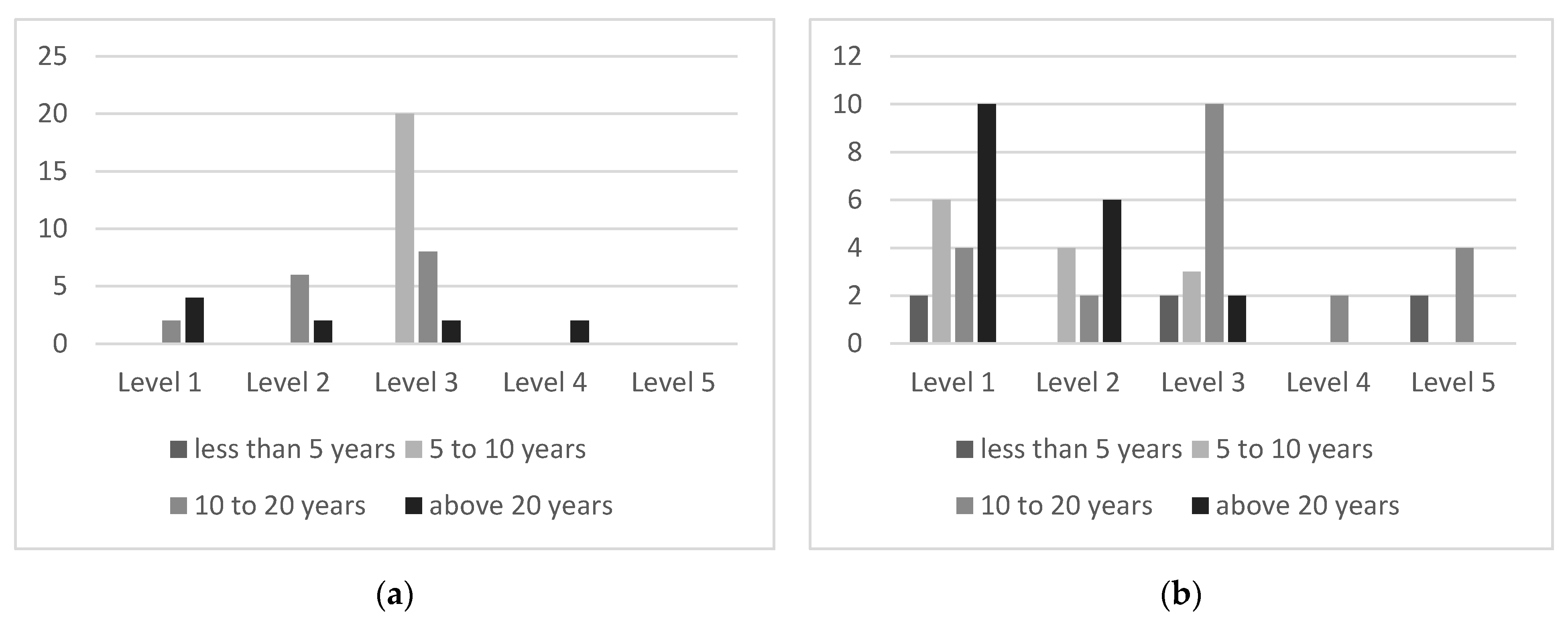
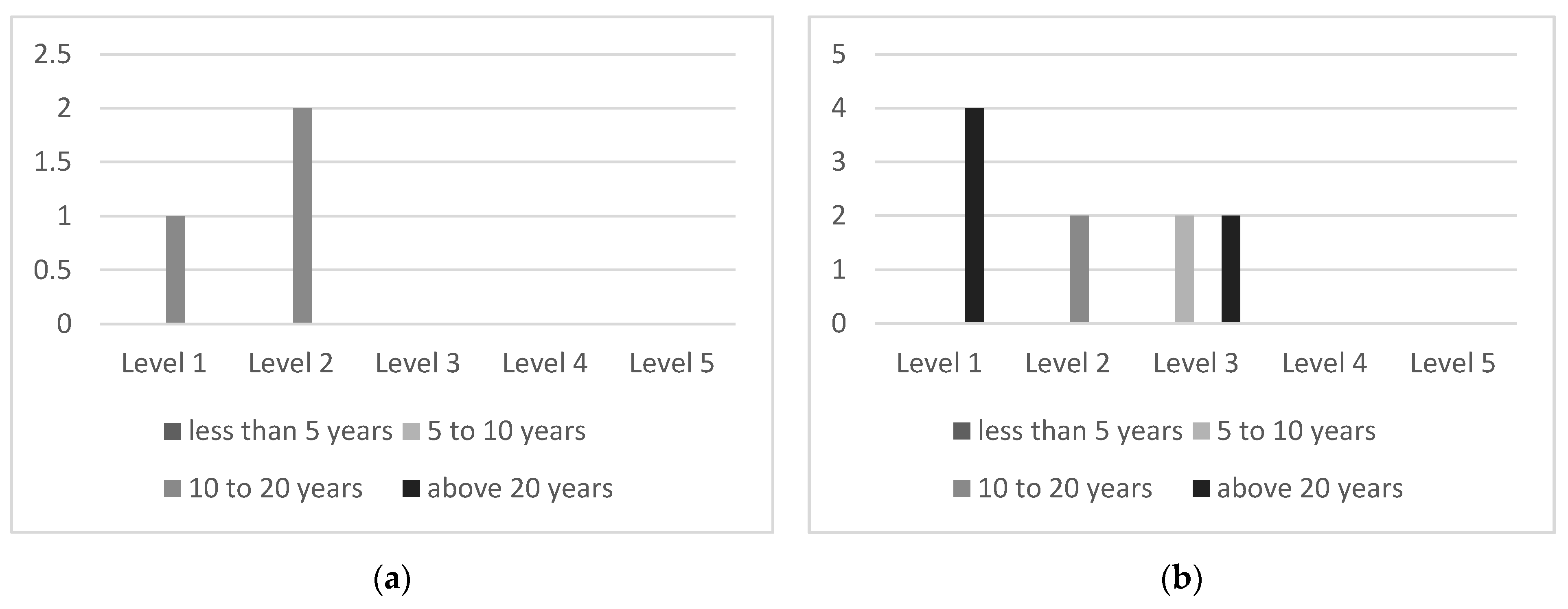
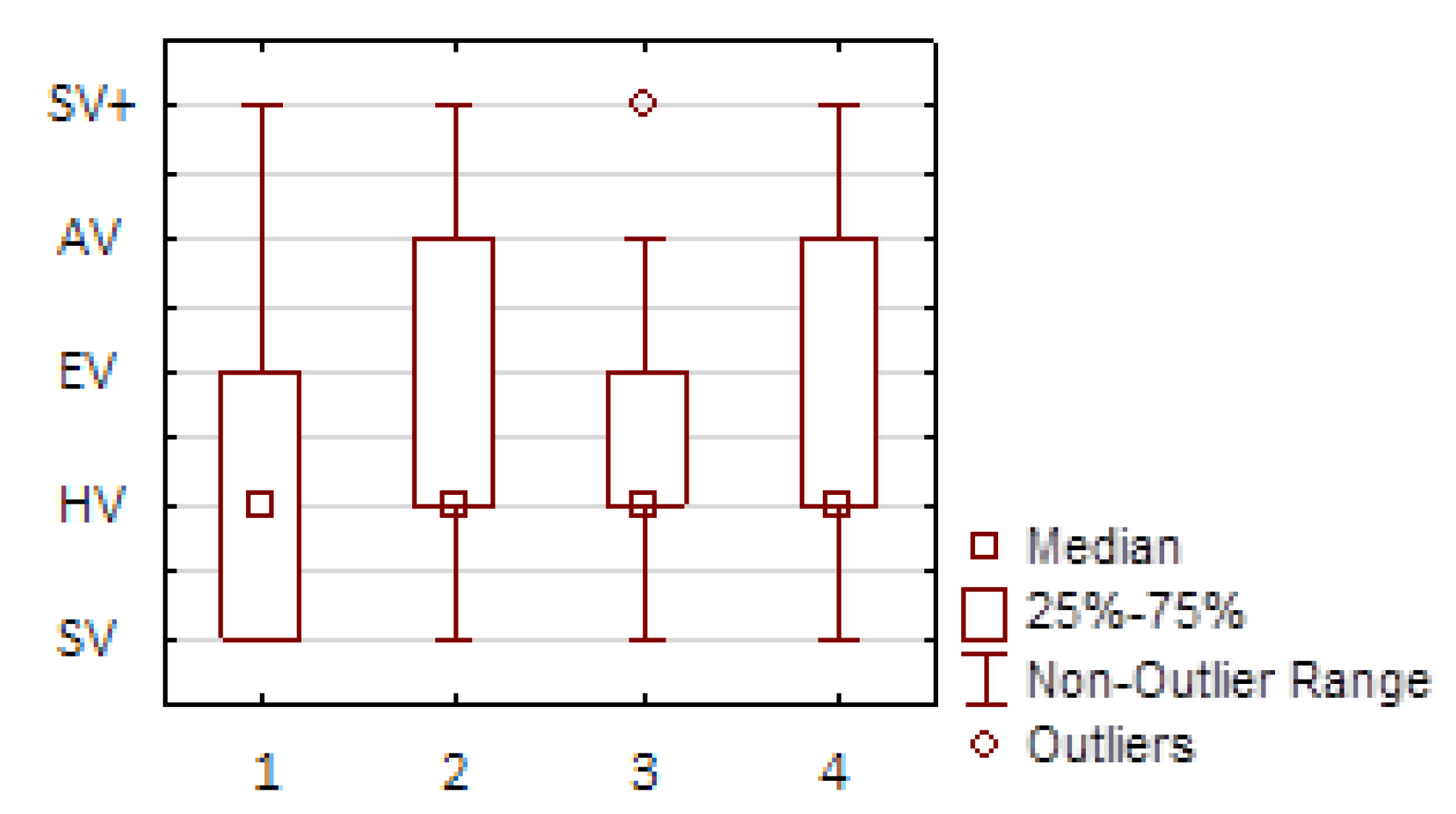
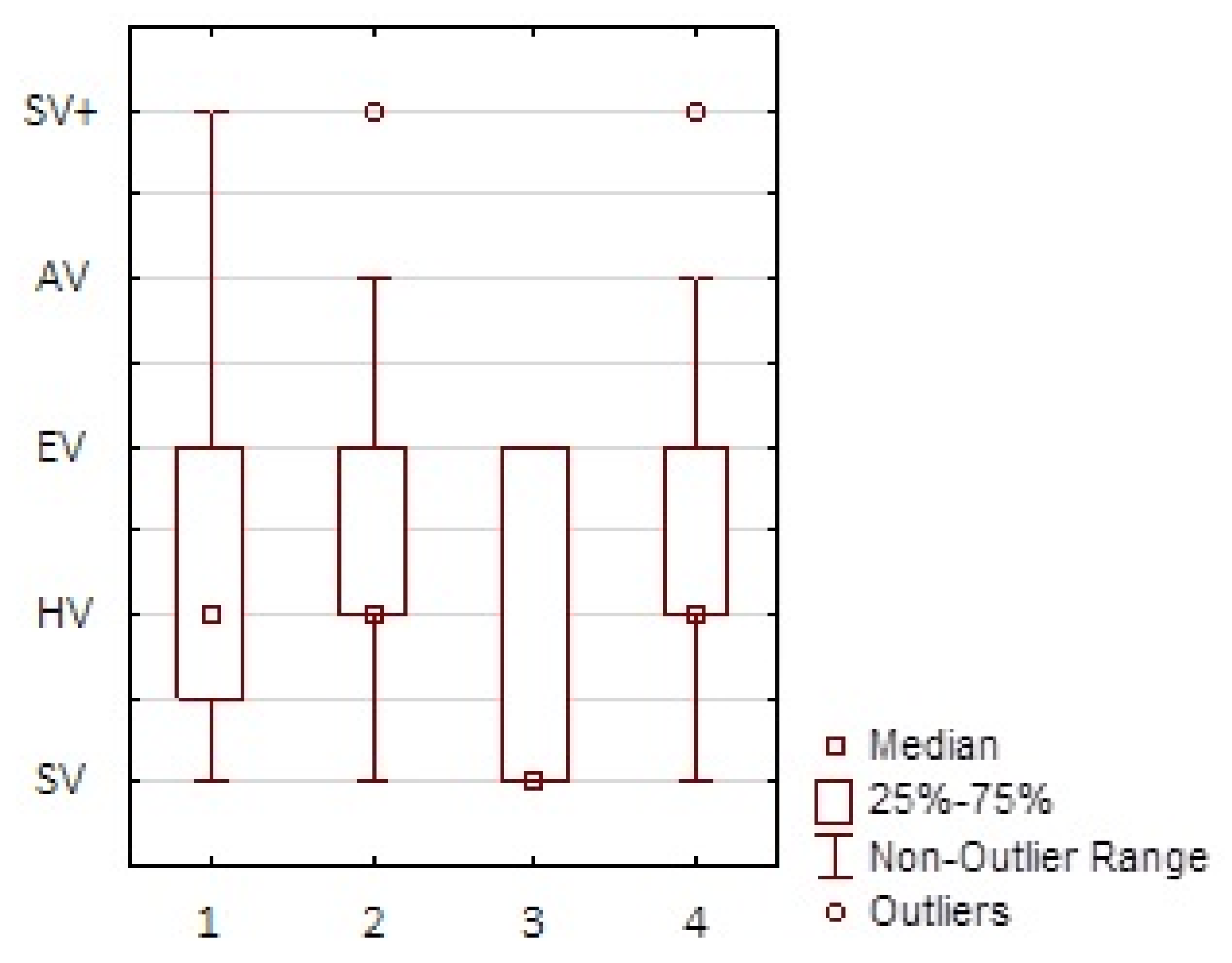
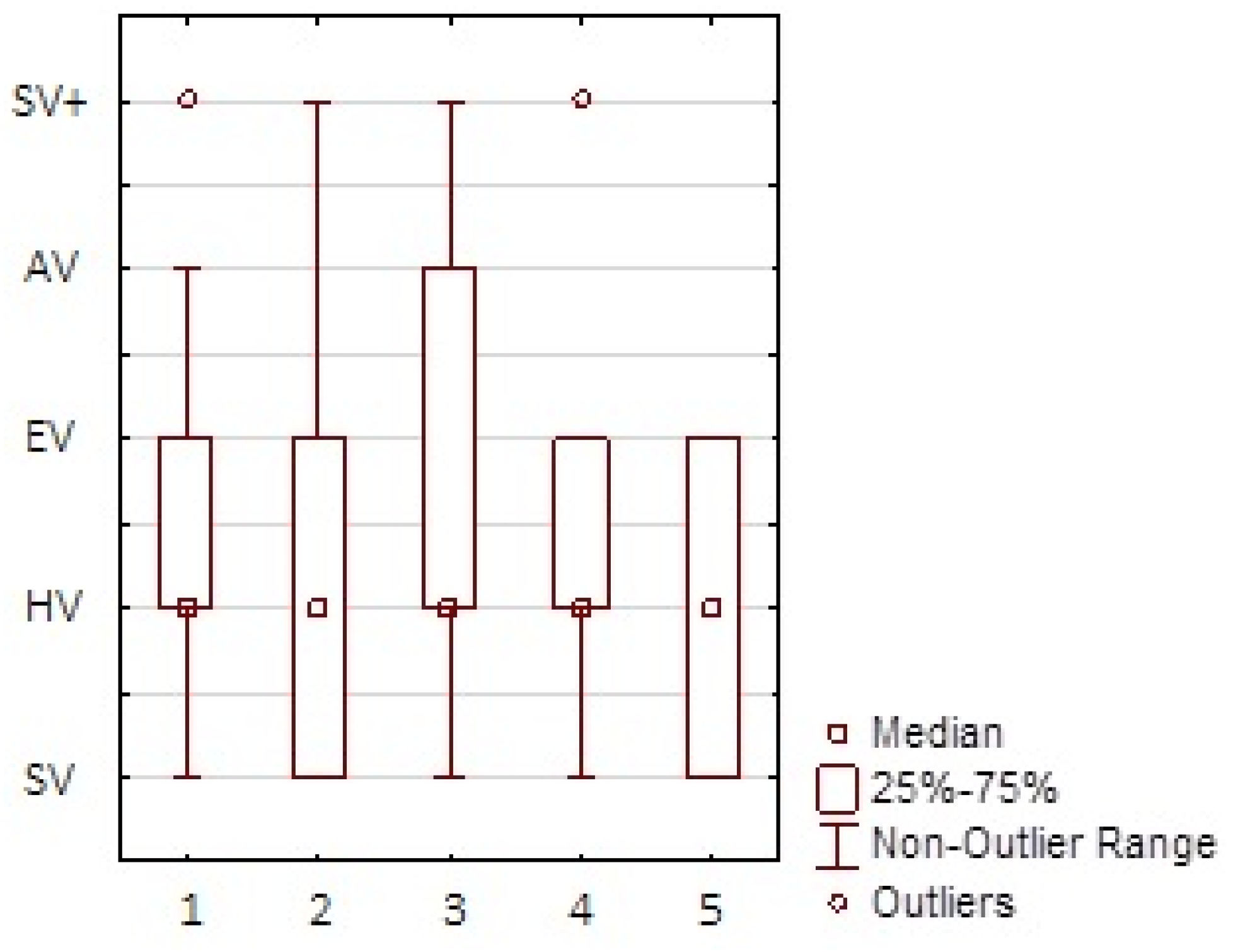
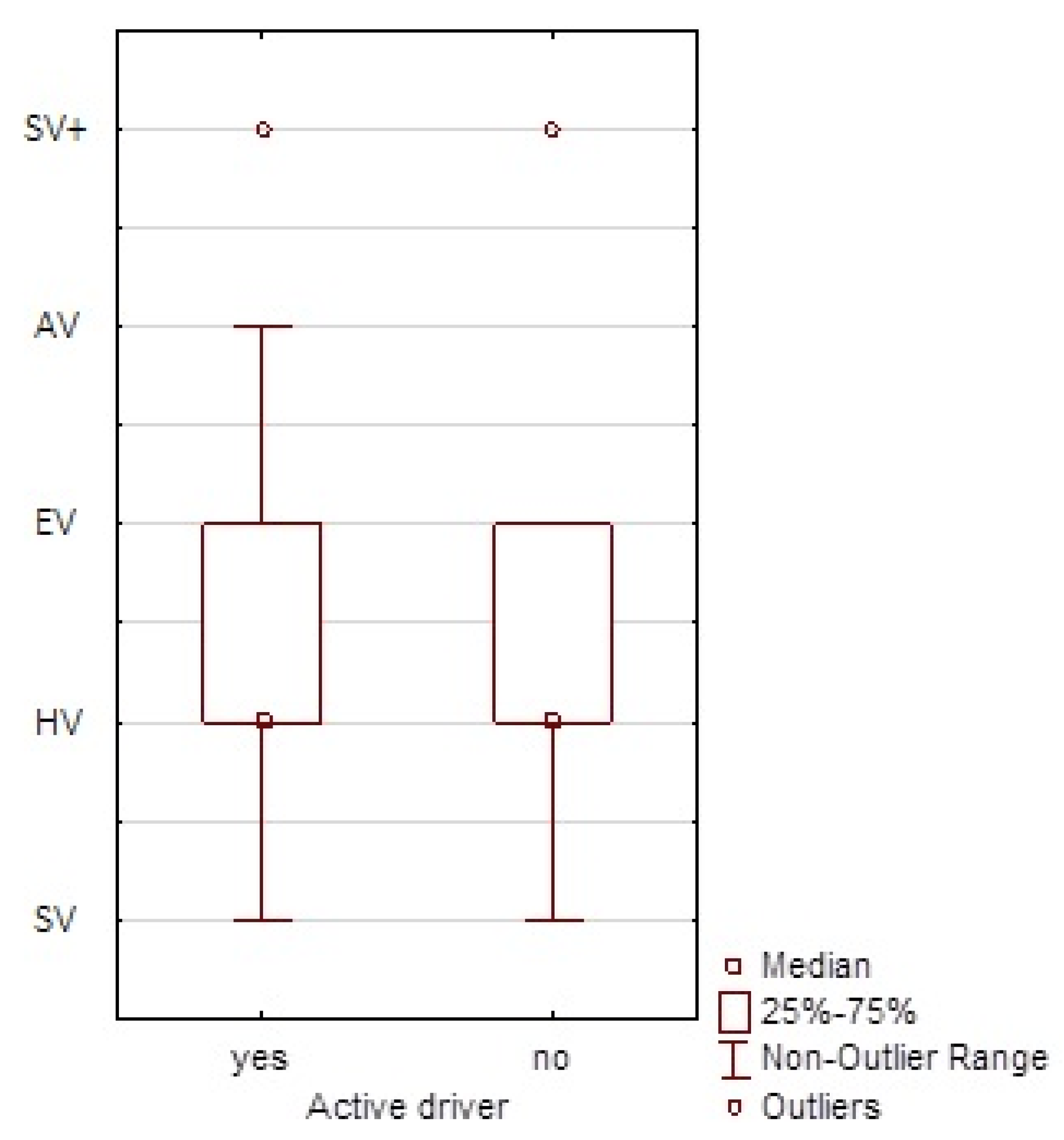
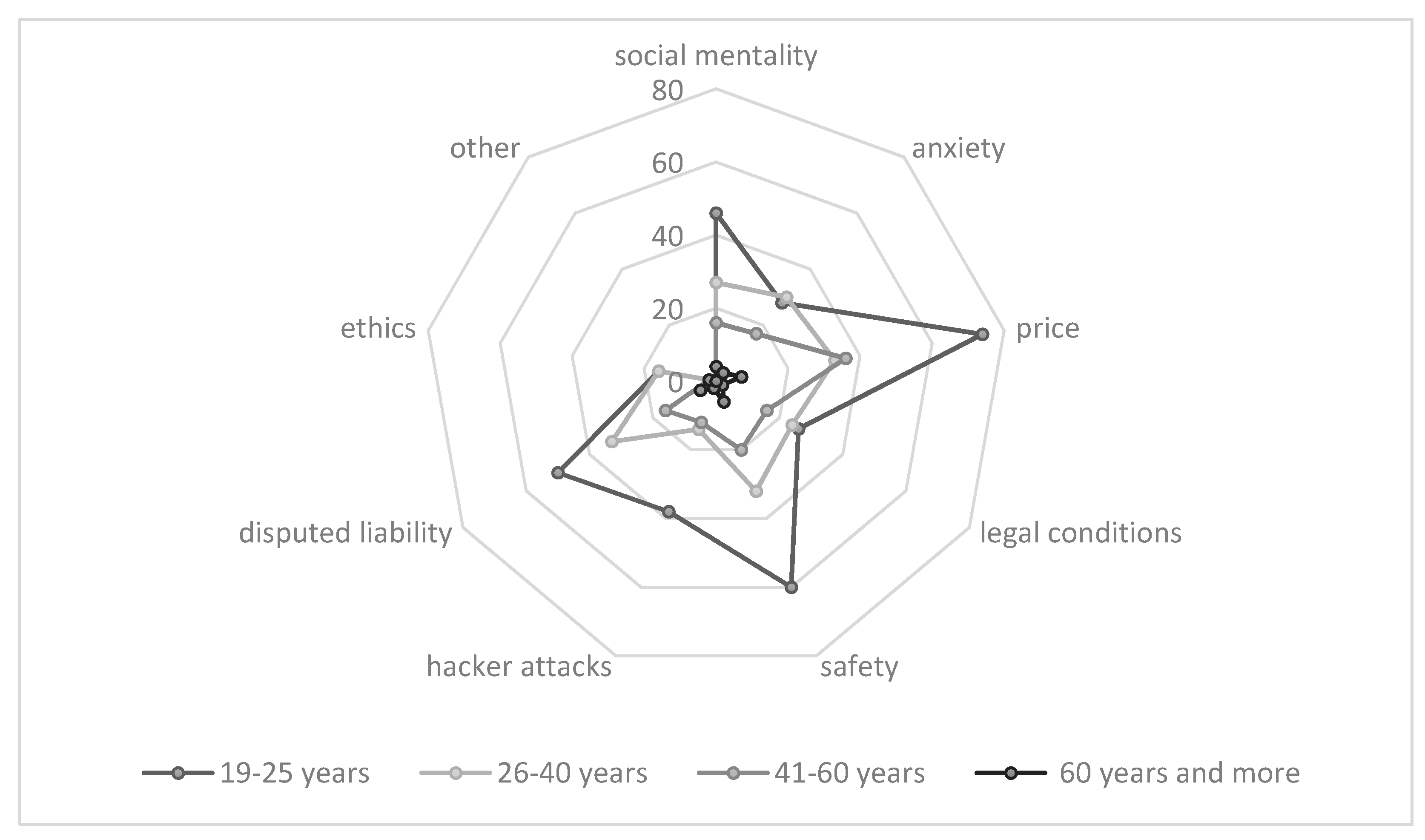
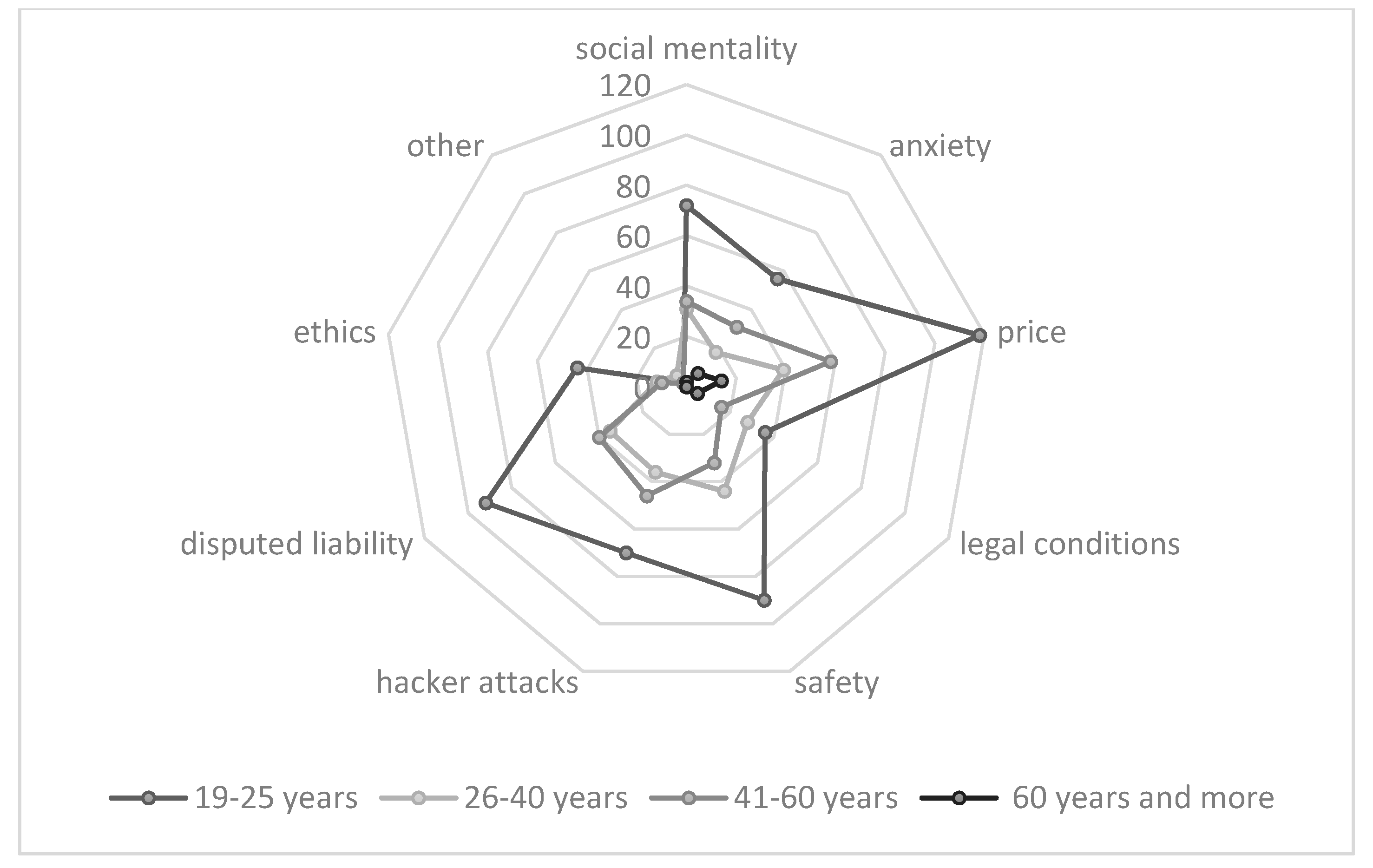
| Socio-Demographic Profile | Number of Respondents | Percentage Share [%] |
|---|---|---|
| Total | 579 | 100.0 |
| Gender: | ||
| Female | 219 | 37.8 |
| Male | 360 | 62.2 |
| Age: | ||
| 19–25 years old | 276 | 47.7 |
| 26–40 years old | 140 | 24.2 |
| 41–60 years old | 138 | 23.8 |
| 60 years and more | 25 | 4.3 |
| Place of residence: | ||
| rural area | 198 | 34.2 |
| city to 100,000 residents | 118 | 20.4 |
| 100,000–300,000 residents | 58 | 10.0 |
| city with more than 300,000 residents | 203 | 35.4 |
| Driving license: | ||
| yes | 506 | 87.4 |
| no | 73 | 12.6 |
| Autonomy Level | Woman | Man | Total |
|---|---|---|---|
| Level 1 | 69 | 114 | 183 |
| Level 2 | 64 | 104 | 168 |
| Level 3 | 61 | 101 | 162 |
| Level 4 | 18 | 30 | 48 |
| Level 5 | 7 | 11 | 18 |
| Generally | 219 | 360 | 579 |
Publisher’s Note: MDPI stays neutral with regard to jurisdictional claims in published maps and institutional affiliations. |
© 2021 by the authors. Licensee MDPI, Basel, Switzerland. This article is an open access article distributed under the terms and conditions of the Creative Commons Attribution (CC BY) license (https://creativecommons.org/licenses/by/4.0/).
Share and Cite
Stoma, M.; Dudziak, A.; Caban, J.; Droździel, P. The Future of Autonomous Vehicles in the Opinion of Automotive Market Users. Energies 2021, 14, 4777. https://doi.org/10.3390/en14164777
Stoma M, Dudziak A, Caban J, Droździel P. The Future of Autonomous Vehicles in the Opinion of Automotive Market Users. Energies. 2021; 14(16):4777. https://doi.org/10.3390/en14164777
Chicago/Turabian StyleStoma, Monika, Agnieszka Dudziak, Jacek Caban, and Paweł Droździel. 2021. "The Future of Autonomous Vehicles in the Opinion of Automotive Market Users" Energies 14, no. 16: 4777. https://doi.org/10.3390/en14164777
APA StyleStoma, M., Dudziak, A., Caban, J., & Droździel, P. (2021). The Future of Autonomous Vehicles in the Opinion of Automotive Market Users. Energies, 14(16), 4777. https://doi.org/10.3390/en14164777







